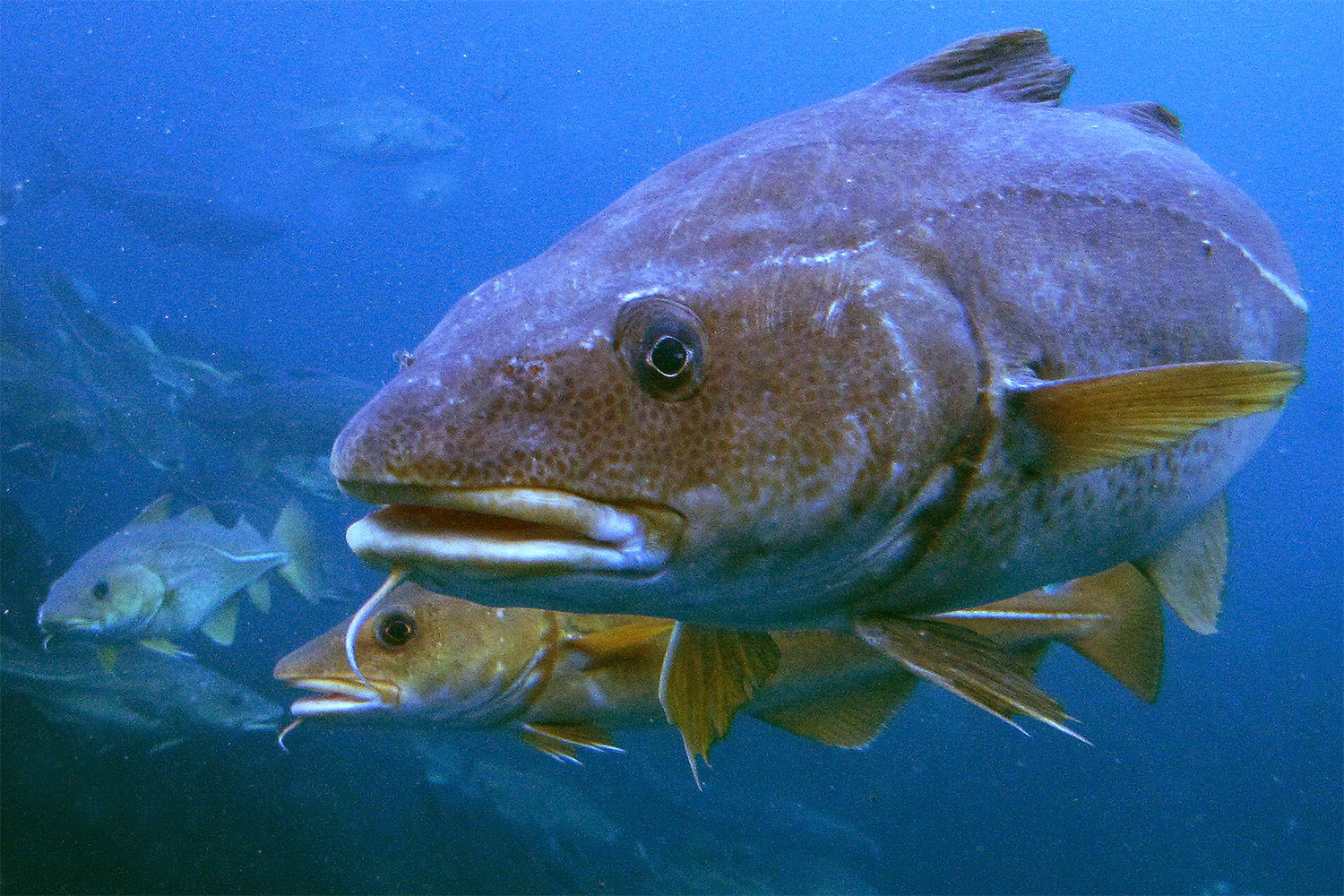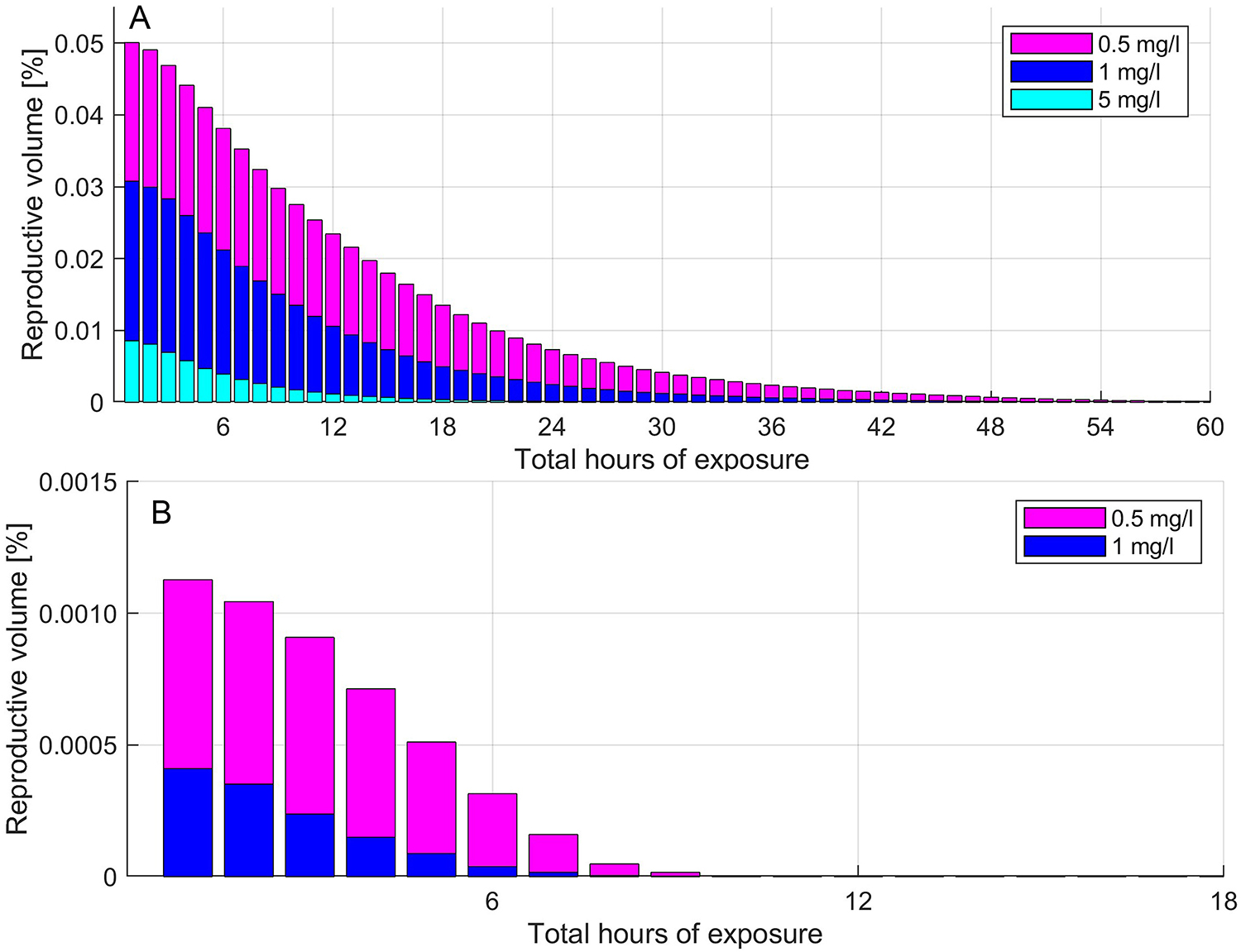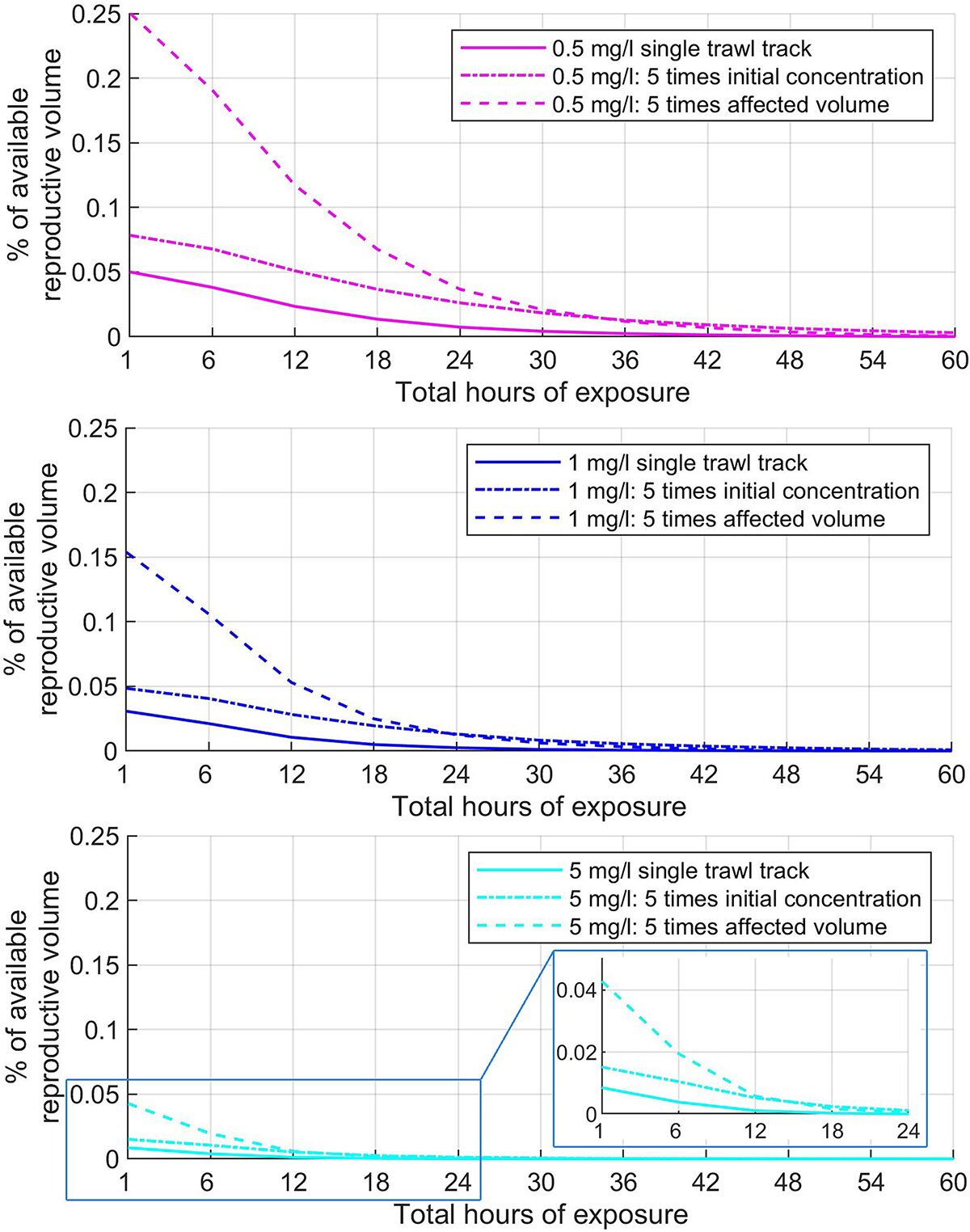Restricting fishing to at least 3 km away from the reproductive volume would minimize potential impacts from sediment suspended by bottom trawling

Bottom trawling is a fishing method used worldwide to catch fish or invertebrates living on or close to the seabed. A range of different fishing gears are used, most commonly beam trawls, otter trawls and various types of dredges, which are dragged along the sea floor. Bottom sediment is suspended by direct contact of the gear with the seabed as well as by turbulence created around the gear. Sediment suspension can be quite substantial, particularly on fine-grained sea beds, with local turbidity in the bottom water reaching many hundred mg per liter and increasing natural turbidity by orders of magnitude.
The sediment plume can be transported kilometers away from the trawl track and, depending on the frequency of trawling, may create areas with semi-permanent increased turbidity and be the main source of suspended sediment in areas with low natural disturbance or at times of year when natural disturbance is low. Few studies have attempted to model the implications of such suspension for sediment transport at a local or regional level, but turbid water has detrimental effects on the physiology, behavior and reproduction of many marine organisms; eggs and larvae appear to be the most sensitive life stages for fish and both concentration of suspended matter and duration of exposure are important.
The Bornholm Basin in the southern Baltic Sea is the last main recruitment area for the threatened Eastern Baltic cod (Gadus morhua). The eggs of this cod population have very specific requirements for survival; they have neutral buoyancy at a relatively narrow range of salinities, with a lower limit at 11 ppt. Together with oxygen requirements, this has led to the concept of a “spawning layer” or “reproductive volume” (RV), defined at its upper boundary by the salinity 11 isobath (an imaginary line on a map connecting all points of equal depth below the surface of a body of water) and at its lower boundary by the 2 ml oxygen per liter of isobath. Decreased buoyancy from suspended sediment adhesion to Baltic cod eggs could therefore lead to eggs sinking out into deep water with unfavorable oxygen conditions.
This article – summarized from the original publication (Corell, H. et al. 2023. Sediment suspended by bottom trawling can reduce reproductive success in a broadcast spawning fish. Estuarine, Coastal and Shelf Science Volume 282, 5 March 2023, 10823) – evaluated if bottom trawling during the cod spawning period could increase suspended sediment concentrations (SSC) to levels that could decrease the time that eggs are buoyant and maintained in the right conditions for survival.
To investigate this, the transport of sediment suspended from two single trawl tracks near the Eastern cod spawning ground in the Bornholm Basin was modeled. The percentage of the RV that could be affected at different excess SSCs, and for how long, were calculated and extrapolated to fishing intensities in the area. The aim was not to perform detailed mechanistic modeling but to understand on a broad scale whether there could be consequences of trawl-suspended sediment for the reproductive success of these pelagic fish eggs.

Trawling-induced sediment suspension could affect cod egg survival
Various studies have examined the conditions required for Eastern Baltic cod egg survival, providing models or relationships based on parameters such as oxygen, salinity and temperature. We estimated that at excess SSCs of 5–0.5 mg per liter it would take 1.7–8.3 days for a cod egg to sink from the top of the RV into unfavorable conditions below. Considering that cod eggs take approximately 14 days to hatch into larvae at 7 degrees-C, this means that there is a significant risk that the eggs will not have sufficient time in the RV to hatch. For eggs that are found deeper in the RV when exposed to suspended sediment, eggs will reach unfavorable conditions even more quickly.
Our estimates should be taken as gross approximations since they are based on extrapolations from a single SSC-egg buoyancy study, and we used a number of assumptions in the calculations. However, as approximations we consider them robust; varying the assumptions of background SSC and sinking times at background SSC did not substantially alter the sinking times at excess SSCs, which remained <14 days and between 8 and 10, 28–35 and 43–52 percent of the sinking time at background SSC (for 5, 1 and 0.5 mg per liter, respectively).

Since cod eggs take around two weeks to hatch under normal conditions, the eggs in the water column at any one point in time are the result of two weeks of accumulated production. Thus, exposure to even a single excess SSC event that causes the eggs to sink out of the RV may in effect eradicate two weeks of egg production in the exposed water volume. It will take days to weeks to replenish the eggs through new spawning and influx from adjacent areas. And with an increasing fraction of the RV affected as the number of trawlers increases and concentrates in the spawning sites within the RV, a proportionally higher fraction of the total number of eggs will have reduced buoyancy and elevated mortality.
This study focused on the implications of increased SSC on cod eggs, but other life stages and species are also negatively impacted by suspended matter. Cod larvae that hatch at or near the bottom of the RV will face sub-optimal oxygen levels, reducing their viability. Suspended sediment in itself also leads to poorer conditions and increased mortality in newly hatched cod yolk-sac larvae at 10 mg per liter.
Even small decreases in egg hatching success or the physiological condition and mortality of eggs and larvae can have large effects on the overall recruitment success and population size. Additionally, changes in the timing of spawning or hatching can be ecologically important since they may cause a mismatch in timing with species that rely on eggs and larvae for food.

Suspension of organic-rich sediments, such as those in the Bornholm Basin, leads to enhanced organic matter remineralization rates by chemical and microbial processes. This can result in a 5–10 percent decrease in oxygen concentration in the water in the 1–2 hours after initial suspension, or as much as 59 percent over c. 12 hours. The Bornholm Basin is already seasonally or permanently hypoxic/anoxic and the areal extent and duration of hypoxia are increasing, so suspended sediment may exacerbate (or already be a partial cause of) this problem. Researchers have reported that bottom trawling and hypoxia act together to impact benthic communities in the southern Baltic. These two stressors overlap and occur in adjacent seabed areas; they are not disconnected, due to temporal and spatial variability.
Our study additionally shows connectivity due to sediment transport. It should also be noted that most trawling in the Bornholm Basin occurs at depths that are rarely disturbed by natural processes such as waves and storms.
Lastly, suspended sediments can contain naturally occurring metals or anthropogenic contaminants, hydrogen sulfide and bacteria that might also contribute to decreased fitness or mortality. Much of the research on the effects of suspended sediment on fish has been done in the context of seabed dredging. These operations require risk assessments of SSC, and measures are often taken to minimize effects on local fauna and flora, for example by carefully choosing the timing of operations. However, these aspects are not considered in the case of bottom trawling, despite it affecting much larger seabed areas.
Implications for fish recruitment and fisheries management
The Eastern Baltic cod stock has been depleted due to historical overfishing and in poor condition for many years, potentially due to low oxygen, food limitation, parasitism and predation. Numbers have decreased, population structure has been altered, recruitment is poor and adults have poor body condition. Previously, recruitment occurred in the Gdansk and Gotland Deeps, but this has been very limited since the 1980s, leaving the Bornholm Basin as the only Eastern cod recruitment ground.
The stability and sustainability of the stock is highly uncertain, and since July 2019 there has been a closure for the cod fishery, though limited bottom trawling has continued for flatfish. The size, shape and time of closure has varied but it only partially covers the spawning area and the time of the closure is too short to cover the whole spawning period. In addition, there is evidence for displacement of fishing effort to the edges of this area during the closed season, which therefore could have maintained excess SSC entering the spawning ground just as eggs are being produced.
Perspectives
This study showed that even a single track from a bottom trawl can cause substantial volumes of water to experience SSC >0.5 mg per liter above background for many days. Scaling up from a single modelled trawl track to five boats fishing simultaneously showed that their positions relative to each other determined the maximum SSC and the total volume affected. Excess SSC may be higher, more frequent or last longer depending on the exact spatiotemporal distribution of fishing effort in or near the RV; mortality of cod eggs and larvae will ultimately depend on the spatial and temporal overlap between spawning and trawling events during the reproductive period for a broadcast spawner like cod.
Moving the perimeter of the seasonal spawning closure outwards would dramatically decrease the SSC entering the spawning area. Our study has shown that SSC 3 km away from a trawl track is still above the background, in line with other studies. Restricting fishing to at least 3 km away from the RV would be a straightforward measure to minimize potential impacts from sediment suspended by bottom trawling. However, the RV is not a static feature but varies both in horizontal and vertical extent within the season and from year to year.
Additionally, peak spawning time has changed over time and seasonal hypoxia is more frequent and prolonged. Previous changes in closure management have apparently not been based on clear biologically based reasoning. From the perspective of trawl-suspended sediment, a scientific rationale could be to prohibit trawling between 50 and 70 meters and not closer than e.g. 3 km to the maximum historical extent of the RV.
Now that you've reached the end of the article ...
… please consider supporting GSA’s mission to advance responsible seafood practices through education, advocacy and third-party assurances. The Advocate aims to document the evolution of responsible seafood practices and share the expansive knowledge of our vast network of contributors.
By becoming a Global Seafood Alliance member, you’re ensuring that all of the pre-competitive work we do through member benefits, resources and events can continue. Individual membership costs just $50 a year.
Not a GSA member? Join us.
Author
-
Hanna Corell, Ph.D.
Corresponding author
DHI Sverige AB, Skeppsbron 28, 11130, Stockholm, Sweden



